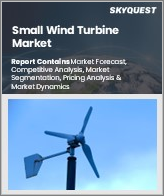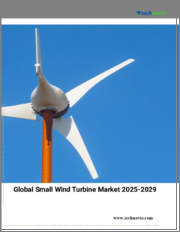
|
시장보고서
상품코드
1346746
소형 풍력 터빈 시장 : 현황 분석 및 예측(2023-2030년)Small Wind Turbine Market: Current Analysis and Forecast (2023-2030) |
||||||
이는 주로 청정 재생 에너지를 촉진하기 위한 정부 프로그램과 인센티브, 그리고 세계에서 청정 에너지에 대한 소비자의 인식이 높아졌기 때문입니다. 소형 풍력발전 시스템은 전기 요금을 50%-90%까지 낮출 수 있습니다. 전력을 공급하고 원격지까지 송전선을 연장하는 데 드는 높은 비용을 피할 수 있으므로 일반적으로 농촌 지역에 도입됩니다. 소형 풍력발전 시스템은 농장이나 목장에서 물을 끌어올리는 등 다양한 용도로도 사용할 수 있습니다.
현재 생산되는 대부분의 소형 풍력 터빈은 2장 또는 3장의 블레이드를 가진 수평축의 풍상형 기계입니다. 이 블레이드는 일반적으로 유리섬유와 같은 복합재료로 만들어집니다. 여러 국가에서 재생 에너지를 장려하고 있으며, 청정 에너지를 늘리기 위해 보조금, 프로그램, 구상 및 유리한 정책을 도입하고 있습니다. 기존 에너지에서 재생 에너지로의 전환은 예측 기간 중 소형 풍력 터빈 시장 성장의 촉매제 역할을 하고 있습니다. 예를 들어 -2022년 12월 미국 에너지부의 경쟁력 향상 프로젝트(CIP)를 통해 국립재생에너지 연구소는 CIP를 통해 11개 중소형 풍력 터빈 기술 제조업체에 290만 달러를 수여할 계획을 발표했습니다. 이 상은 1메가와트 미만의 풍력 터빈 제조업체에 수여되며, Bergey Windpower Company는 이 프로젝트에 후보로 선정된 주요 기업 중 하나입니다.
소형 풍력 터빈 시장은 축 유형에 따라 수평축 풍력 터빈과 수직축 풍력 터빈으로 나뉩니다. 수평축 풍력 터빈은 소형 풍력 터빈 시장에서 대부분의 점유율을 차지하고 있으며, 예측 기간 중 큰 성장률을 보일 것으로 예상됩니다. 수평축 풍력 터빈은 메인 로터 샤프트와 발전기가 타워 상단에 설치되어 있으며, 간단한 풍향풍속계를 통해 바람을 탁월하게 만들거나 탁월하지 않은 바람을 향하게 할 수 있습니다. 대부분의 소형 수직축 풍력 터빈은 최근 10년간 건설된 반면, 수평축 풍력 터빈은 30년 이상 전부터 생산되어 왔습니다. 소형 수평축 풍력 터빈은 관련 기술 및 경제적 이점으로 인해 추진력을 얻고 있습니다. 풍속이 높은 소형 수평축 풍력 터빈은 저렴한 비용으로 풍력발전을 할 수 있고, 숙련공이 필요하지 않으며, 정비가 용이합니다. 수직축 풍력 터빈은 주택 부문이 주요 개발 지역이기 때문에 크게 성장하고 있습니다.
시장 세분화는 용도에 따라 온-그리드 및 오프-그리드로 나뉩니다. Off-grid 부문은 소형 풍력 터빈 시장에서 대부분의 점유율을 차지하고 있으며, 예측 기간 중 상당한 성장률을 보일 것으로 예상됩니다. Off-grid 소형 풍력발전은 저개발 국가와 개발도상국의 외딴 지역에서 중요한 역할을 하고 있습니다. Off-grid 용도에는 농촌 주택 전기화, 통신 스테이션, 해양 발전 등이 포함됩니다. 이러한 오프 그리드 용도의 소형 풍력 터빈은 에너지 저장을 위해 배터리로 연결할 수 있습니다. 최근 수년간 저장 배터리의 가격이 하락함에 따라 소형 풍력발전 시스템과 저장 배터리를 오프 그리드 커뮤니티에서 사용하는 것이 경제적으로 가능해졌습니다. 이러한 풍력 터빈은 송배전 인프라가 노후화된 지역이나 전력 부족이 발생하기 쉬운 기상 조건이 열악한 지역에 적합합니다.
소형 풍력 터빈 시장 도입에 대한 이해를 돕기 위해 시장은 북미(미국, 캐나다, 기타 북미), 유럽(독일, 이탈리아, 영국, 네덜란드, 프랑스, 기타 유럽), 아시아태평양(중국, 일본, 호주, 한국, 기타 아시아태평양), 세계 기타 지역으로 분석됩니다. 기타 지역에서의 세계 존재를 기준으로 분석되었습니다. 아시아태평양은 소형 풍력 터빈 시장에서 가장 높은 시장 점유율을 기록했으며 예측 기간 중 영향력있는 CAGR을 목격할 것으로 예상됩니다. 이는 주로 중국, 인도, 호주, 한국, 일본에서 많은 소형 풍력 터빈 프로젝트가 진행 중이기 때문입니다. 또한 각국이 설정한 재생 에너지 목표 달성을 위한 유리한 정부 정책, 규제 및 투자가 시장을 주도하고 있습니다. 중국은 북부 국가전력망(State Grid)과 남부 중국남방전력망(China Southern Power Grid)의 대규모 투자로 소형 풍력터빈 시장의 주요 시장 참여 기업가 되었습니다. 중국 정부는 비수력 재생에너지 비중을 2030년 최대 25.9%, 2035년 최대 36.0%로 설정하고, 2030년까지 풍력과 태양광의 총 설비용량을 120만kW 이상으로 확대한다는 목표를 세웠습니다. 풍력에너지를 촉진하는 보조금과 우대 정책은 예측 기간 중 아시아태평양 소형 풍력 터빈 시장 성장의 촉매제가 될 것입니다.
이 시장에 진출한 주요 기업 : Bergey Windpower Co, Northern Power Systems Inc., Wind Energy Solutions, UNITRON Energy Systems Pvt. Green Energy Co.
목차
제1장 시장 서론
- 시장의 정의
- 주요 목표
- 이해관계자
- 제한사항
제2장 조사 방법 또는 전제
- 조사 프로세스
- 조사 방법
- 응답자 개요
제3장 시장의 주요 인사이트
제4장 주요 요약
제5장 세계의 소형 풍력 터빈 시장 신종 코로나바이러스 감염증(COVID-19)의 영향
제6장 세계의 소형 풍력 터빈 시장 매출, 2020-2030년
제7장 축 유형별 시장 인사이트
- 수평축 풍력 터빈
- 수직축 풍력 터빈
제8장 용도별 시장 인사이트
- 온그리드
- 오프그리드
제9장 지역별 시장 인사이트
- 북미의 소형 풍력 터빈 시장
- 미국
- 캐나다
- 기타 북미 지역
- 유럽의 소형 풍력 터빈 시장
- 독일
- 이탈리아
- 영국
- 프랑스
- 스페인
- 기타 유럽 지역
- 아시아태평양의 소형 풍력 터빈 시장
- 중국
- 일본
- 호주
- 인도
- 아시아태평양의 기타 국가
- 기타 지역의 소형 풍력 터빈 시장
제10장 소형 풍력 터빈 시장 역학
- 시장 촉진요인
- 시장이 해결해야 할 과제
- 영향 분석
제11장 소형 풍력 터빈 시장 기회
제12장 소형 풍력 터빈 시장 동향
제13장 수요측과 공급측 분석
- 수요측 분석
- 공급측 분석
제14장 밸류체인 분석
제15장 경쟁 시나리오
- 경쟁 구도
- Porter's Five Forces 분석
- 기업 순위 분석
제16장 기업 개요
- Bergey Windpower Co.
- SD Wind Energy
- Aeolos Wind Energy Ltd.
- Ryse Energy
- Northern Power Systems Inc.
- City Windmills Holdings PLC
- Wind Energy Solutions
- UNITRON Energy Systems Pvt. Ltd
- Shanghai Ghrepower Green Energy Co. Ltd
- TUGE Energia OU
제17장 면책사항
KSA 23.10.18Small wind turbines, also called micro wind turbines, generate electricity with small consumption. These turbines are typically smaller than those found in wind farms. In contrast to active wind turbines, small wind turbines are often equipped with passive yaw systems. These use direct-drive generators and have their tails pointed into the wind, while the larger turbines have geared drivetrains and are actively pointed into the wind. They typically produce 500W to 10kW, but some are as low as 50W.
It is mainly owing to the government programs and incentives to promote cleaner renewable energy and increasing consumer awareness towards cleaner energy globally. Small wind electric systems can lower electricity bills by 50%-90%. It is typically deployed in rural areas as it provides electricity and avoids the high costs of having utility power lines extended to a remote location. Small wind electric systems can also be used for a variety of other applications, including water pumping on farms and ranches.
The majority of small wind turbines manufactured today are horizontal-axis, upwind machines with two or three blades. These blades are typically made of composite materials, such as fiberglass. Various nations are promoting renewable energy and have introduced subsidies, programmes, initiatives, and favorable policies in order to increase clean energy. The shift towards renewable energy from conventional energy is acting as a catalyst in the growth of the small wind turbine market during the forecast period. For instance - In December 2022, The National Renewable Energy Laboratory through the U.S. Department of Energy's Competitiveness Improvement Project (CIP) announced plans to award $2.9 million to 11 manufacturers of small- and medium-scale wind turbine technology through CIP. These awards are given to manufacturers of wind turbines less than 1 megawatt in capacity. Bergey Windpower Company was one of the key companies nominated for this project.
Based on Axis Type, The Small Wind Turbine market is divided into Horizontal Axis and Vertical Axis Wind Turbine segments. The Horizontal Axis Wind Turbine segment acquired a majority share in the Small Wind Turbine market and is expected to showcase a substantial growth rate during the forecast period. In a Horizontal Axis Wind Turbine, the main rotor shaft and generator are located at the top of a tower and can be directed into or away from the prevailing wind by a simple wind vane. While most small vertical axis wind turbines have been built in the last decade, the horizontal axis wind turbine has been in production for over 30 years. Small-scale horizontal axis turbines are gaining momentum due to the associated techno-economic advantages. Small horizontal axis wind turbines with high wind speeds enable wind power generation at low cost, do not require skilled labor and are easy to maintain. The vertical axis wind turbine is growing majorly due to the residential sector as they are the main deployment region of these turbines.
Based on Application, the Small Wind Turbine market is segmented into On-Grid and Off-Grid segments. The Off-Grid segment acquired a majority share in the Small Wind Turbine market and is expected to showcase a substantial growth rate during the forecast period. Off-grid small wind energy plays an important role in remote areas of underdeveloped and developing countries. Off-grid applications include rural residential electrification, telecommunication stations, offshore power generation, etc. These small wind turbines for off-grid applications can be connected to batteries for energy storage. As the cost of energy storage batteries has dropped in recent years, small wind power systems and storage batteries have become more economically viable for use in off-grid communities. These wind turbines are suited for areas where the transmission and distribution infrastructure is aging and areas with harsh weather conditions that are prone to power shortages.
For a better understanding of the market adoption of Small Wind Turbine, the market is analyzed based on its worldwide presence in the countries such as North America (U.S.A, Canada, and the Rest of North America), Europe (Germany, Italy, United Kingdom, Netherlands, France, and Rest of Europe), Asia-Pacific (China, Japan, Australia, South Korea, and Rest of Asia-Pacific) and Rest of World. APAC registered the highest market share in the Small Wind Turbine market and is expected to witness an influential CAGR in the forecasted period. It is mainly owing to many Small Wind Turbine projects taking place in China, India, Australia, South Korea, and Japan. Moreover, favorable government policies, regulations, and investments in achieving renewable energy targets set by various countries are driving the market. China has become a major player in the Small Wind Turbine market due to massive investments from the State Grid in the North and China Southern Power Grid in the South. The Chinese government has set targets for the share of non-hydro renewables of up to 25.9% in 2030 and 36.0% in 2035, expanding its total installed capacity of wind and solar power to over 1 200 GW by 2030. Subsidies and incentives promoting wind energy will act as a catalyst in the growth of the APAC Small Wind Turbine Market during the forecast period.
Some of the major players operating in the market are: Bergey Windpower Co., SD Wind Energy, Aeolos Wind Energy Ltd., Ryse Energy, Northern Power Systems Inc., Northern Power Systems Inc., Wind Energy Solutions, UNITRON Energy Systems Pvt. Ltd, Shanghai Ghrepower Green Energy Co. Ltd, and TUGE Energia OU.
TABLE OF CONTENTS
1 MARKET INTRODUCTION
- 1.1. Market Definitions
- 1.2. Main Objective
- 1.3. Stakeholders
- 1.4. Limitation
2 RESEARCH METHODOLOGY OR ASSUMPTION
- 2.1. Research Process of the Small Wind Turbine Market
- 2.2. Research Methodology of the Small Wind Turbine Market
- 2.3. Respondent Profile
3 MARKET KEY INSIGHTS
4 EXECUTIVE SUMMARY
5 GLOBAL SMALL WIND TURBINE MARKET COVID-19 IMPACT
6 GLOBAL SMALL WIND TURBINE MARKET REVENUE, 2020-2030F
7 MARKET INSIGHTS BY AXIS TYPE
- 7.1. Horizontal Axis Wind Turbine
- 7.2. Vertical Axis Wind Turbine
8 MARKET INSIGHTS BY APPLICATION
- 8.1. On-Grid
- 8.2. Off-Grid
9 MARKET INSIGHTS BY REGION
- 9.1. North America Small Wind Turbine Market
- 9.1.1. U.S.A
- 9.1.2. Canada
- 9.1.3. Rest of North America
- 9.2. Europe Small Wind Turbine Market
- 9.2.1. Germany
- 9.2.2. Italy
- 9.2.3. United Kingdom
- 9.2.4. France
- 9.2.5. Spain
- 9.2.6. Rest of Europe
- 9.3. Asia-Pacific Small Wind Turbine Market
- 9.3.1. China
- 9.3.2. Japan
- 9.3.3. Australia
- 9.3.4. India
- 9.3.5. Rest of APAC
- 9.4. Rest of the World Small Wind Turbine Market
10 SMALL WIND TURBINE MARKET DYNAMICS
- 10.1. Market Drivers
- 10.2. Market Challenges
- 10.3. Impact Analysis
11 SMALL WIND TURBINE MARKET OPPORTUNITIES
12 SMALL WIND TURBINE MARKET TRENDS
13 DEMAND AND SUPPLY-SIDE ANALYSIS
- 13.1. Demand Side Analysis
- 13.2. Supply Side Analysis
14 VALUE CHAIN ANALYSIS
15 COMPETITIVE SCENARIO
- 15.1. Competitive Landscape
- 15.1.1. Porters Fiver Forces Analysis
- 15.1.2. Company Ranking Analysis
16 COMPANY PROFILED
- 16.1. Bergey Windpower Co.
- 16.2. SD Wind Energy
- 16.3. Aeolos Wind Energy Ltd.
- 16.4. Ryse Energy
- 16.5. Northern Power Systems Inc.
- 16.6. City Windmills Holdings PLC
- 16.7. Wind Energy Solutions
- 16.8. UNITRON Energy Systems Pvt. Ltd
- 16.9. Shanghai Ghrepower Green Energy Co. Ltd
- 16.10. TUGE Energia OU















